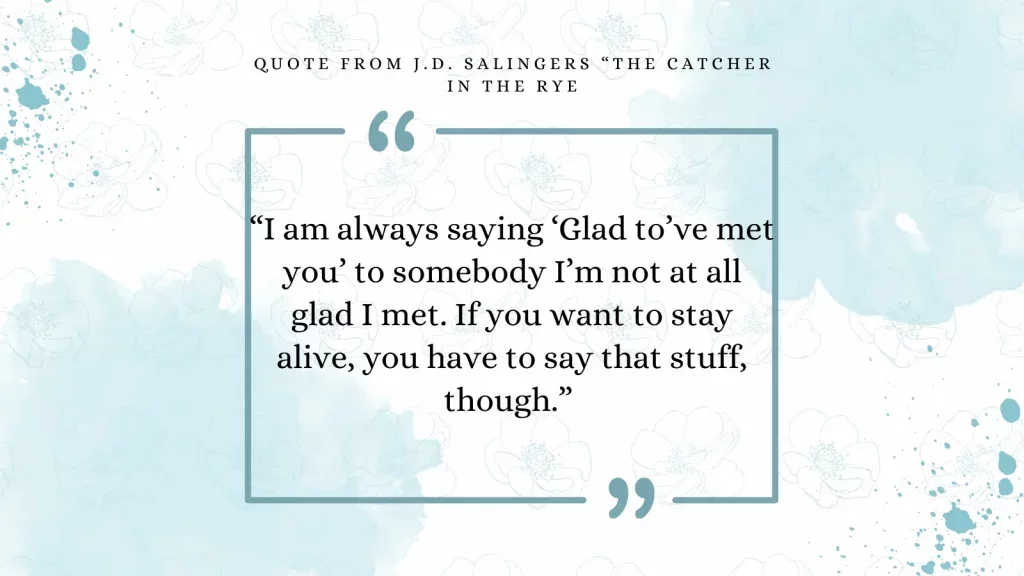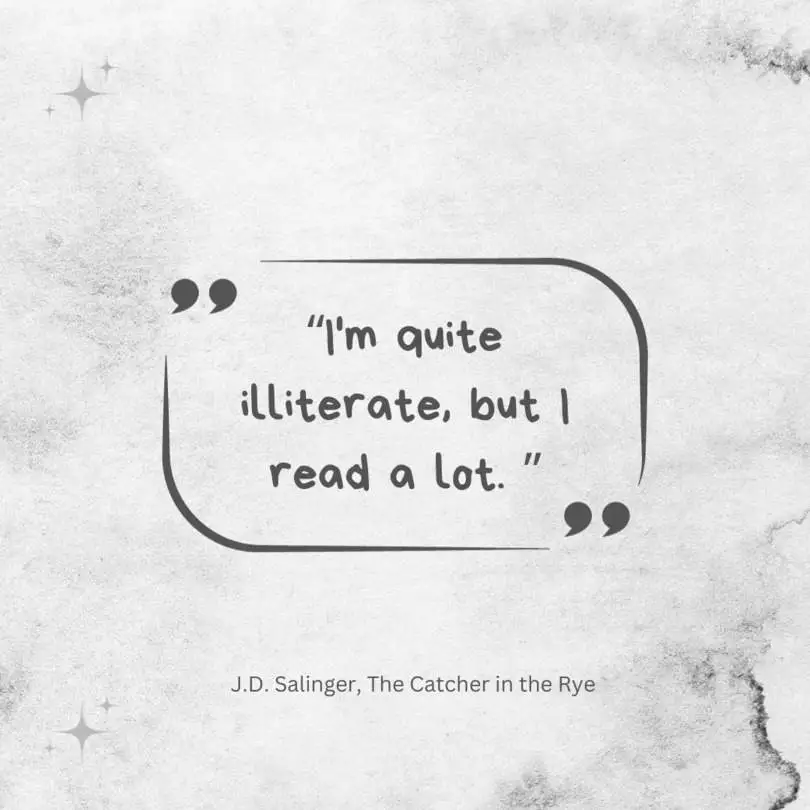“The Catcher in the Rye” by J.D. Salinger: A Timeless Classic of Adolescent Alienation
My Thoughts on “The Catcher in the Rye” by J.D. Salinger
Reading “The Catcher, in the Rye” by J.D. Salinger really opened my eyes. When I first met Holden Caulfield I was immediately pulled into his world of struggles and defiance. His authentic and sincere voice struck a chord with me prompting me to reflect on my feelings and experiences. As I followed Holdens journey through New York City his battles with self identity, grief and isolation felt incredibly genuine and relatable. The novels examination of innocence and the challenges of growing up deeply impacted me turning it into more than a tale but a reflection of my path to self discovery.
Holdens rejection of the superficiality of adulthood resonated with me. Like him I began to question standards and pressures. His strong desire to safeguard childrens innocence portrayed through his aspiration to be the “catcher in the rye ” echoed my own fears and aspirations regarding maturity. The vivid depictions of his mind and emotional turmoil made me feel as though I was right beside him experiencing his loneliness and bewilderment.
By the time I reached the end of the book I felt a bond, with Holden.
His tale of seeking purpose in a world that appeared unconcerned resonated with my doubts and challenges. “The Catcher, in the Rye” wasn’t merely a book I perused; it was a journey that influenced how I perceived youth and the intricacies of feelings, in people.
“The Catcher in the Rye” by American Author J.D. Salinger is a timeless classic that continues to resonate with readers of all ages. First published in 1951, the novel is a compelling exploration of adolescent alienation, rebellion, and the search for authenticity in an artificial world. Through the voice of its protagonist, Holden Caulfield, Salinger presents a poignant and often controversial critique of society, making the novel a thought-provoking and enduring work of literature. This review delves into the thematic depth, narrative style, and lasting impact of “The Catcher in the Rye.”
Plot Summary: The Catcher in the Rye
“The Catcher in the Rye” unfolds over a few days in the life of sixteen-year-old Holden Caulfield, who has been expelled from his preparatory school, Pencey Prep. After bidding farewell to his roommate, Holden embarks on a restless journey through New York City before returning home to face his parents. Throughout his odyssey, Holden encounters various characters, engages in introspection, and grapples with his conflicting emotions.
Themes:
Alienation and the search for authenticity are central themes in “The Catcher in the Rye.” Holden Caulfield feels disconnected from the adult world, which he perceives as hypocritical and artificial. He struggles to find meaning and genuine connections, often yearning for a sense of belonging that eludes him. This theme of alienation resonates with readers of all generations, as many can relate to the feeling of being an outsider or grappling with the complexities of adulthood.
Identity and individuality are also prominent themes in the novel. Holden Caulfield resists conformity and rejects societal expectations. He yearns for individuality, rejecting the phoniness he perceives in others and striving to preserve his own authenticity. This struggle for identity is a universal theme, particularly for young readers navigating their own paths of self-discovery and asserting their individuality in the face of societal pressures.

Narrative Style:
One of the most distinctive aspects of “The Catcher in the Rye” is Salinger’s masterful use of first-person narration. The novel is presented as Holden Caulfield’s stream-of-consciousness account, allowing readers to intimately connect with his thoughts, emotions, and experiences. The conversational tone and colloquial language immerse readers in Holden’s mind, capturing the essence of his character and the authenticity of his voice. The narrative style creates an immediacy that draws readers into Holden’s world and elicits empathy for his struggles.
Holden’s voice is filled with teenage angst, cynicism, and occasional moments of vulnerability. His thoughts are often fragmented and tangential, reflecting the confusion and turmoil of adolescence. While some readers may find Holden’s narration repetitive or excessive, it is precisely this unfiltered and authentic portrayal of a troubled teenager that gives the novel its emotional depth and enduring appeal.
Characterization:
Holden Caulfield is an enigmatic and complex character who simultaneously repels and fascinates readers. Salinger expertly crafts a protagonist who embodies the universal struggles of adolescence. Holden’s rebellious nature, sensitive disposition, and yearning for authenticity make him relatable to readers of all backgrounds. His flaws and contradictions invite readers to examine their own fears, insecurities, and desire for genuine connections.
The secondary characters in the novel also contribute to its richness. From Holden’s younger sister, Phoebe, who embodies innocence and understanding, to the iconic “phony” characters such as Sally Hayes and Holden’s former teacher, Mr. Antolini, each character serves as a mirror through which Holden confronts his own insecurities and confronts the phoniness he despises.
Controversy and Impact: “The Catcher in the Rye”
“The Catcher in the Rye” has not been without controversy. Its frank exploration of adolescent sexuality, use of profanity, and unapologetic critique of societal norms have caused the novel to be both celebrated and banned in various educational institutions. However, it is precisely this candid and unfiltered portrayal of adolescence that contributes to the novel’s impact and enduring relevance.
“The Catcher in the Rye” has resonated with generations of readers, particularly young adults grappling with the transition into adulthood. Its honest depiction of teenage disillusionment, alienation, and the search for authenticity continues to strike a chord. The novel has become a touchstone for disenchanted youth, a literary companion for those navigating the complexities of adolescence and seeking solace in Holden Caulfield’s journey.

Famous Quotes from J.D. Salingers “The Catcher in the Rye”
- “What really knocks me out is a book that, when you’re all done reading it, you wish the author that wrote it was a terrific friend of yours and you could call him up on the phone whenever you felt like it. That doesn’t happen much, though.” – This reflects the protagonist Holden Caulfield’s longing for genuine connection and understanding, a theme that permeates the novel.
- “The mark of the immature man is that he wants to die nobly for a cause, while the mark of the mature man is that he wants to live humbly for one.” – Attributed to Mr. Antolini, this quote encapsulates one of the book’s central ideas about growing up and the values that define maturity.
- “People always clap for the wrong reasons.” – With this observation, Holden critiques the superficiality and inauthenticity he perceives in the adult world.
- “I’m quite illiterate, but I read a lot.” – This quote from Holden highlights his complex relationship with knowledge and education, underscoring his intelligence but also his disdain for formal schooling and conventional wisdom.
- “Don’t ever tell anybody anything. If you do, you start missing everybody.” – This closing line of the novel speaks to Holden’s deep sense of isolation and his ambivalent relationship with connection and vulnerability.
- “It’s funny. All you have to do is say something nobody understands and they’ll do practically anything you want them to.” – Here, Holden reflects on the power of language and how it can be used to manipulate or control situations, revealing his cynicism towards adult behavior.
- “The best thing, though, in that museum was that everything always stayed right where it was. Nobody’d move… Nobody’d be different. The only thing that would be different would be you.” – Holden’s affection for the Museum of Natural History in New York City illustrates his desire for a world that is predictable and unchanging, highlighting his fear of change and the passage of time.
- “Anyway, I keep picturing all these little kids playing some game in this big field of rye and all. Thousands of little kids, and nobody’s around – nobody big, I mean – except me. And I’m standing on the edge of some crazy cliff. What I have to do, I have to catch everybody if they start to go over the cliff…” – This quote is where the title of the novel comes from. It reveals Holden’s desire to protect the innocence of childhood from the corruption of adulthood.

Trivia Facts about “The Catcher in the Rye”
- Initial Publication in Serial Form: Before “The Catcher in the Rye” was published as a novel in 1951, parts of it appeared in serial form in “Collier’s” magazine in 1945-46. However, it underwent significant revisions before reaching its final form.
- Salinger’s Dislike of Hollywood: Despite receiving numerous offers, J.D. Salinger famously refused to sell the movie rights to “The Catcher in the Rye,” expressing disdain for Hollywood and fearing that the film industry would not do justice to his work.
- A Favorite Among Assassins and Criminals: The novel has been associated with several infamous figures. Most notably, Mark David Chapman was carrying the book when he murdered John Lennon in 1980, and he later claimed the book’s story was his motive. John Hinckley Jr., who attempted to assassinate President Ronald Reagan, and Robert John Bardo, who murdered actress Rebecca Schaeffer, were also reported to be obsessed with the novel.
- Working Title: The original title for the novel was “The Catcher in the Rye, a novel by J.D. Salinger: A novel dealing with the evasion of an ingenious youth from the ‘phoneyness’ of the adult world to the integrity of innocence.”
- Salinger’s Personal Connection: J.D. Salinger is said to have had a deep personal connection with his protagonist, Holden Caulfield. Like Holden, Salinger attended prep schools, had trouble fitting in, and was critical of the adult world. Salinger also served in World War II, an experience that deeply affected him and influenced his writing.
- A Classic of Teen Rebellion: Though it was originally intended for adults, “The Catcher in the Rye” quickly became a symbol of teenage rebellion and angst, resonating with adolescent readers who identified with Holden’s disdain for the “phony” nature of the adult world.
- Banned and Challenged: The novel has been frequently banned and challenged in schools across the United States due to its profanity, themes of sexuality, and criticism of traditional values. Despite (or perhaps because of) this, it remains one of the most studied, discussed, and revered works of 20th-century American literature.
- Limited Merchandising: Unlike many classic novels, “The Catcher in the Rye” has seen very little in the way of official merchandising, adaptations, or sequels, primarily due to Salinger’s stringent control over his work and his estate’s continuation of his policies.
- A Literary Enigma: Salinger’s reclusiveness added to the mystique of “The Catcher in the Rye.” After its publication, Salinger gradually withdrew from public life and published very little. He gave his last interview in 1980 and lived in seclusion in Cornish, New Hampshire, until his death in 2010.
- Enduring Legacy: Despite its controversies, or perhaps because of them, “The Catcher in the Rye” remains a critical part of American literary canon, continuously attracting new generations of readers and scholars interested in its themes of alienation, loss of innocence, and the search for identity in a post-war world.
Conclusion: The Catcher in the Rye
“The Catcher in the Rye” by J.D. Salinger remains a literary masterpiece that captivates readers with its timeless themes and compelling narrative. Through the introspective lens of Holden Caulfield, Salinger explores the universal struggles of adolescence, alienation, and the search for authenticity. The novel’s enduring appeal lies in its honest portrayal of teenage angst, the power of its first-person narration, and its ability to provoke introspection and empathy in readers.
“The Catcher in the Rye” serves as a poignant reminder that the quest for identity, the desire for genuine connections, and the longing for authenticity are timeless human experiences. Salinger’s exploration of these themes, coupled with his masterful storytelling and authentic characterization, solidifies the novel’s place as a seminal work of literature that continues to inspire, provoke, and resonate with readers of all ages.
More Reviews from J.D. Salinger
A Review of “Raise High the Roof Beam, Carpenters and Seymour: An Introduction” In the realm of enigmatic literature, where…
The Human Tapestry: A Review of “Nine Stories” by J.D. Salinger In J.D. Salinger’s collection of short stories titled “Nine…
A Soul-Stirring Sibling Saga – “Franny and Zooey” by J.D. Salinger Quick Summary: My Thoughts on Franny and Zooey by…


